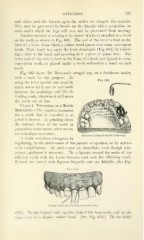Page 731 - My FlipBook
P. 731
EXTRUSION. 729
and either push the laterals up iu the socket or elongate the centrals.
This may be prevented by bands on the laterals with a projection on
each, under which the lugs will rest and be prevented from moving.
Another method of rotating is bv means of a lever attached to a band
on the tooth as shown in Fig. 680. The end of the lever is bent in the
form of a hook, from which a rubber baud passes over some convenient
tooth. Prof. Angle has made the lever detachable (Fig. 681) by solder-
ing a tube to the band and inserting in it a piece of piano wire. The
other end of the wire is bent in the form of a hook and ligated to some
convenient tooth, or placed under a hook soldered to a baud on such
tooth.
Fig. 682 shows Dr. Matteson's swaged cap on a deciduous molar,
with a hook for this purpose. In
Fig. 682.
using the lever special care must be
taken not to let it rest on any tooth
between the anchorage and the of-
fending tooth, otherwise it will move
the tooth out of line.
Class 4. Extrusion, or a Tooth
Extruded.—The simplest treatment
for a tooth that is extruded is to
grind it shorter. As grinding alters
the natural shape of the tooth in
proportion to its extent, other means
are sometimes necessary.
Mattusiiu's swaged cap for anchorage.
A tooth sometimes elongates, in
regulating, by the carelessness of the patient or operator, or by unfore-
seen complications. In such a case an immediate, even though tem-
porary, appliance is necessary. Tie a ligature around the necks of the
adjacent teeth with the knots between each and the oifending tooth.
Extend one end of each ligature lingually and one labially. (See Fig.
ri(i.oy:j.
Writer's plan for reducing extruded teeth.
683.) Tie the lingual end.-^ together behind the long tooth, and in the
same knot tie a slender rubber band. (See Fig. 684.) Tie the labial


